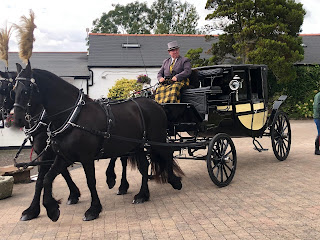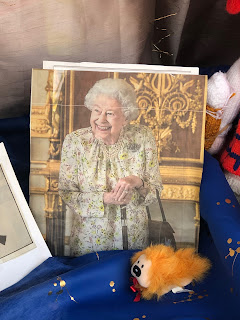This morning was our final one in the Lake District, and we bid fond farewell to Margaret, our hostess, and to the new friends that we met while staying at the Dower House. Marty made one last drive along the walled curvy roads, into Ambleside, where we managed to find the Mater Amabilis Roman Catholic Church for 9:30 Mass. We never did find the church parking lot, but settled on a Pay and Display Lot several blocks away. This resulted in us hiking uphill for those several blocks, but we still managed to get inside before Mass began.
Sunday, September 18, 2022
Over the Border to Scotland
Mass included some lovely prayers for the Royal Family, as well as the new King, as they cope with the loss of their dearly loved queen, who we must remember, was also their beloved mum and grandmum.
Heading back down the hill to the car presented quite a challenge, as the roadsters were driving as if they were in the Great Race. And, you know what? This sign didn't even help us!
So much for that! But we finally did make it to the lot, retrieve our car, and headed to Cockermouth.
It didn't take long for the roads to widen, making the drive a lot less stressful.
In this village stands the childhood home of William Wordsworth, noted Scottish poet.
The house stands from 1760, and was home to John Wordsworth and his family. He was employed as a legal agent for the First Earl of Lonsdale, and it is quite obvious while touring the house, that this family lived quite a comfortable life here.
The kitchen was one of the largest that I've ever seen, particularly for such a modest sized house.
The dining table was set with creations that would have been served in the late 1770s. I found the hedgehog to be quite entertaining.
Note the ornateness of the bedrooms
John and his wife had separate, adjoining rooms. Her's led to the hallway and was across from the parlor where the family would have entertained.
The wooden piece holding books in the right side of this room actually belonged to Wordsworth, and was donated by his granddaughter to the National Trust.
The children's bedroom held some unique toys that would have been in fashion during the same time period.
A tiny child's chair stood next to the fireplace in the parlor.
The back of the house featured a lovely large garden that led out towards the river.
We were told when we entered the house, that it was set up to reflect the same house that William would have lived in at the time. But his time spent here would be short-lived, with his mother dying when he was at the age of eight. At this point, he was sent to the school in Hawkshead, which we actually saw yesterday, but had no idea that there was a connection.
It was the white building on the left.
His childhood story was a sad one, with his mum dying when he was eight, and his father dying five years later. At that point, he would never set foot in this house again. But his fame is well known here as he helped to launch the Romantic Age of English literature.
We took a few minutes to ramble through the village. There was a retired brewery
a castle ruins visible from along the river
and beautiful display of flowers leading up to the statue of the Earl of Mayo.
And there were the beautiful tributes to the queen displayed in shop windows.
Our final destination for the day was Moffat, but we decided to make a stop in Gretna Green, as we had plenty of time to do so.
The village brings to mind those novels in English literature, where love struck runaways, too young to marry without parental permission in their English village, would escape to Gretna Green to be married in the Blacksmith Shop. The tradition of marriage in Gretna Green continues, but only as a romantic gesture, and we were witness to many young men and woman dressed in wedding attire.
There was a bagpiper for entertainment
and a horse and buggy to deliver the bride to the doorway.
All in all, it was great fun to watch and to just walk around.
But it began to rain, (no surprise there), so we opted to head onto our final destination, Moffat.
We checked into our B&B, where we were greeted with tea and lemon drizzle cake.
Wasn't that a nice treat?
We then headed into the town for a stroll. The village is nestled in a valley with hills rising up around, and is actually quite a bit larger than what I had anticipated.
This unique statue stands in the center of town, adorned with colorful flowers at its base.
I knew that Marty would enjoy this bench that had several eagles carved into it.
There was a WWI memorial
and a lovely clock tower.
I had reserved dinner at Brodies, and, once again, we were fortunate that I did so, because they were fully booked when we arrived.
This was a unique restaurant, and far different from our usual venue, but I must say, I'm sure that it is the best meal that we have had on this trip! The attention from the staff was excellent, and the food was fabulous.
The view was pretty nice as well
Once again, the village had the queen's image displayed in various shops, and here is another one that I had yet to see.
We were returning to our B&B after dinner, when we spotted a crowd standing outside the town hall. Tiny candles flickered in the dark, then we heard the chiming of the town bell, and a bagpiper began to play while the bell chimed on. I then realized that there was one ring for each year the queen had served as regent.
It was truly a touching and memorable experience to witness such a solemn event.
Tomorrow is the state funeral for the queen, and nearly every establishment will be closed out of respect for her final ceremonies. Who would have ever dreamed that we would be in this beautiful country for such a historic event? So, rather than fret over cancelled plans, we will make the best out of whatever the day offers us.
Saturday, September 17, 2022
The Charm of Beatrix Potter
Today was certainly an educational day for us, as well as a visual delight, as we headed to Hilltop, the National Trust site that features the house where she created so many of those familiar stories involving the antics of Peter Rabbit, Benjamin Bunny, Squirrel Nutkin and Tom Kitten, to name just a few.
Everything in the house was owned by Beatrix. It was obvious that she had come from a wealthy family, because the average farmhand would not have rare and unusual items among the possessions.
Her parents had been worth quite a substantial amount of money, but they were not of the gentry. Her father had wished for Beatrix to marry someone who was titled, as her cousin had done, but Beatrix was not interested in that. Her father was not a fan of her writings, so the only way that she could find the time to write uninterrupted, was to purchase the house, called Hilltop, as a refuge for her inspiration.
It was in the Lake District where she wrote many of her works, and it was here that she came to love this Lake District area, and she set about doing whatever she could to be sure that the beauty would be preserved for future generations.
The rooms were filled with family items that she had preserved for her own enjoyment.
There was this unique collection of brass ornaments, some commemorating an important event in British History. They hung upon the stove in the kitchen.
A porcelain teapot honoring King Edward VII and Queen Alexandria.
Isn't just lovely?
And here are just a few of the many items on display:
a mantle place in one of the rooms
a sampler stitched in the year 1822
and a pitcher with a saying that one could say definitely described Beatrix's view on life.
Let the wealthy and great
Roll in splendor and hate
I envy them not I declare it;
I eat my own lamb. My own chickens and ham.
I shear my own fleece and I wear it.
I have lawns, I have bowers. I have fruits. I have flowers.
The lark is my morning alarmed;
So you jolly bows now
Here's God bless the Plough.
Long life and success to the farmer.
There was a collection of Peter Rabbit fine china, which I learned was actually commissioned by Beatrix after her book became popular.
These were many, many more items, including the original stuffed Peter Rabbit doll, but it was behind glass and it was too difficult to capture a photo.
Beatrix never had any children, but it would be easy to imagine that these delightful characters meant as much to her as any child would have.
She was not only a writer, but also an illustrator, and we found it fascinating to learn that many of the items in her house were featured in the illustrations of the stories. In fact, we were encouraged to scroll through the books in each room, to see if we could match a drawing with an item in that room. It really was quite fun….kind of like a treasure hunt….and we were excited when we could make the match.
Take a look for yourself at what Marty and I managed to find:
Wasn't that fun?
Beatrix partnered with the National Trust, and used her wealth to purchase at least five properties in this area. She was concerned that industrialists would come in and buy the land, and that they would build manufacturing plants, spoiling all of its beauty.
The land continues to be farmed by local tenants, and we can thank her persistence and generosity for this unspoiled beauty to enjoy for future generations.
In addition to this newfound knowledge regarding Beatrix’s passion, I was surprised to learn that her books were favored far more in America than in her homeland. The tour guide told us that they are always excited to see Americans because they consider us to be the driving force for keeping Beatrix’s memory alive. Now, how nice was that to learn?
From here, it was a short jaunt to Claife Viewing Station. It was built in 1790 as a viewpoint for visitors to look over Windermere lake. One has to climb a series of stone steps to get to the top, but once there, the view is pretty amazing.
Of course, we had to stop and read about fish.
On the way back, I captured a shot of the station from below.
It really was such a clever idea for that time period, and I found it interesting that people in the late 1700s had the same eagerness to look out and enjoy such a beautiful view.
From here, we headed towards Dalton Castle to take a peek at what that had to offer. This structure was built sometime after 1320 as a Pele tower, designed as a fortress to defend the region. In addition, it was a courthouse, gaol, and a home for the Abbots to secure law and order within its walls.
There really wasn’t much to see, except the guide was extremely excited to take us to see the dungeon, and she encouraged me to climb up the turret to the upper floor.
The stairs were quite difficult to navigate, due to being a circular nature, uneven with many of them crumbling a bit. I’m fairly certain that I surprised the guide on the upstairs level when I came crawling up, as it was the only way I could manage to get up there.
Once upstairs, there were a few items of interest, particularly the architecture.
And an interesting set of chairs under the large window, one featuring a fish, which seemed appropriate enough to post here since it seems to be the constant query on Marty's mind.
From here, I ventured into the next room, and lo and behold, there was a set of perfectly "normal" steps that I could have taken and saved myself the challenge of navigating the turret. I suppose the guide wanted to see if I was up to the challenge. Well, it appears that I was!
Dinner was in Hawkshead, another quaint village that we enjoyed exploring.
This map of the town really amused me. I loved the clever way that Beatrix Potter's characters are interspersed throughout the map.
It certainly seems to me that someone other than Americans are crazy about her characters as well.
It's been a grand three days here in the Lake District. We've met two lovely couples while staying here, and one of the guests shared Marty's enthusiasm for fishing. I came downstairs to find Marty showing off his portable fishing gear to him.
Looks like there just might be a future follower of Yinzerfishing to add to the list!
Subscribe to:
Comments (Atom)


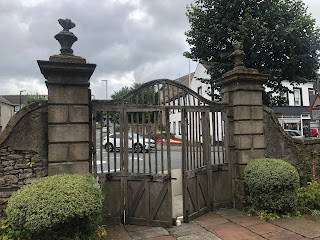









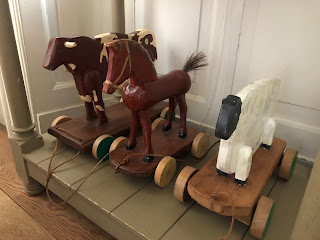





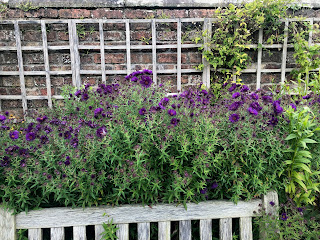

.jpeg)









